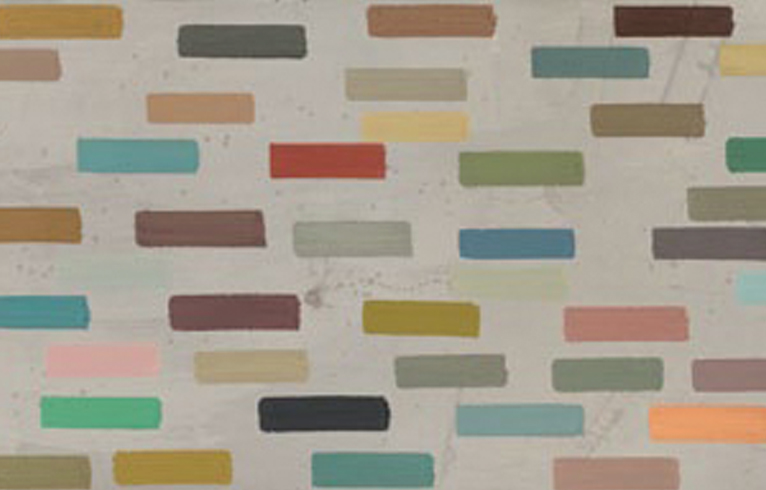ANIWAR: WIND WITHOUT RAIN
| December 23, 2011 | Post In LEAP 11

A comprehensive article by archaeologist and translator Bruce Doar portrays Aniwar as a refined traveler in the manner of a solitary, spiritual nomad. This uncommon aura is borne out by the paintings, drawings, and felt works shown recently at Platform China. Vivid yet earthy, they seemed attuned to the natural world and its moods, colors, and patterns. Bold, expertly combined pigments are layered in rectangular brushstrokes, tightening into minimalist blocks; flat bars of gold leaf strike their way onto the canvas. As viewers, we are encouraged to succumb to these compositions in a willing suspension of “ordinary” visual perception which, the artist feels, is habitually two-dimensional.
In the opening room, a series of small, diaristic drawings (2008) showing crowds of shifting horizontal lines offer insight into the daily contours of Aniwar’s abstract vision; then, as if to initiate one into an appropriate mental state, there is a small room completely given over to an intricate example of his kigiz felt panel works. Titled Wool, Wind and Rain (2010), it is displayed on the wall mounted against a wire mesh support. Shapes resembling fallen leaves and stalks, crosses, upright and flat-lying lines, and birds populate its beige surface in ochre, pink, brick red, and green. Dim lighting and a row of chairs invite one to sit quietly and contemplate the complex handcrafted design, which subtly infuses minimalist language with naive spatial play.
Standing before The Rain in One Afternoon in 2008, one senses not only the physical impact of the elements— the paint is spattered like rain on glass and tarmac, drops contracting into pearls or smudges— but also atmospheric buildup and discharge as expressed in a maelstrom of pale color wash. Aniwar does sometimes work outside, but far from being impressionistic, his canvases are born of changing natural stimuli and an inner spiritual passage that channels his creative energy. His 2008 works are invariably of this dense, layered kind. Upon closer inspection, their surfaces betray an array of techniques; paint has been dripped quickly from above, revealing a relationship between artist and work at once spiritual and physical. In Raining in Autumn, for example, the paint surface has been sanded off in places, and some globules are cracked from exposure. The memorable golden dashes, too, are born not as before of expressive gestures but as gold leaf meticulously laid over select strokes. These surface treatments contribute to a view of Aniwar’s work as finely decorative. Nevertheless, these paintings’ immersive quality, and the juxtaposition of strong horizontals and nebulous areas of light pigment, serve to mitigate the flatness of the picture plane.
If the works from 2008 are the most cumulative and variegated, then earlier works seem shallower. All Wishes Come True (2006), for example, employs acid acrylic color that verges, like its title, on kitsch. But paintings of the same vintage— economical, abstract, and flatly colored— depart significantly from both tendencies. Wind Without Rain, the horizontal painting that provides the exhibition title, is starkly deliberate, resisting an indulgence of surface. An untitled work from this year looms, more painterly and with something reminiscent of a figure or form amongst three central clusters of diagonal marks. There is little sense of loss despite much having been subtracted from these new paintings— although some may miss the golden strokes.
Aside from the near-shamanistic quality ascribed to Aniwar’s works as beautiful syntheses of external and inner event, of climate and persona, they deserve consistent attention for the subtle balances and juxtapositions they achieve in terms of color and technique, space and surface, minimalism and tactile craft. It seems now that his work is on the move in a new direction, one that we can assume will not be taken lightly. Iona Whittaker

